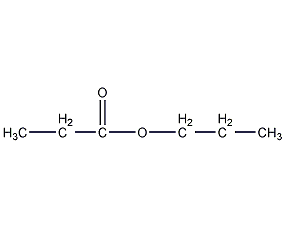n-Propyl propionate n-Propyl propionate


Structural formula
| Business number | 02T8 |
|---|---|
| Molecular formula | C6H12O2 |
| Molecular weight | 116.16 |
| label |
propyl propionate, n-propyl propionate, 1-Propylpropanoate, n-Propyl n-propionate, n-Propyl propanoate, Propanoic acid propyl ester, aliphatic compounds |
Numbering system
CAS number:106-36-5
MDL number:MFCD00009373
EINECS number:203-389-7
RTECS number:UF7100000
BRN number:None
PubChem ID:None
Physical property data
1. Properties: colorless liquid.
2. Boiling point (ºC, 101.3kPa): 122.5
3. Melting point (ºC): -75.9
4. Relative density (g/mL, 20/4ºC): 0.8817
5. Relative density (g/mL, 25/4ºC): 0.8767
6. Relative vapor density (g/mL, air=1): 4.01
7. Refractive index (n20ºC): 1.3932
8. Refractive index (n25ºC): 1.3920
9. Viscosity (mPa·s,20ºC) :0.68
10. Flash point (ºC, closed): 19
11. Relative evaporation rate (ether = 1): 15.1
12. Vapor pressure (kPa, 20ºC): 1.40
13. Flash point (ºC): 476.7
14. Solubility: Miscible with ethanol and ether, slightly soluble in water.
15. Critical temperature (ºC): 296.85
16. Critical pressure (MPa): 3.06
17. Eccentricity factor: 0.376
18. Solubility parameter (J·cm-3)0.5: 17.326
19. van der Waals area (cm2 ·mol-1): 1.049×1010
20. van der Waals volume (cm3·mol-1): 73.230
21. Liquid phase standard hot melt (J·mol-1·K-1):225.9
Toxicological data
1. Skin/eye irritation
Standard Draize test: rabbit, skin contact: 500mg/24H, severity of reaction: moderate.
Standard Draize test: Rabbit, eye contact: 100 mg, severity of reaction: moderate.
2. Acute toxicity: rat oral LD50: 10331mg/kg; mouse inhalation LC50: 24mg/m3/2H; rabbit oral LD50: 3950mg/kg ; Rabbit skin contact LD50: >14128mg/kg; Rat inhalation LC50: 16900mg/m3;
3. Other multiple dose toxicity: Rat oral TDLo: 4mg/m3/4H/88D-I;
Ecological data
This substance is slightly hazardous to water.
Molecular structure data
1. Molar refractive index: 31.62
2. Molar volume (cm3/mol): 131.0
3. Isotonic specific volume (90.2K ): 295.5
4. Surface tension (dyne/cm): 25.8
5. Dielectric constant:
6. Dipole moment (10-24cm3):
7. Polarizability: 12.53
Compute chemical data
1. Reference value for hydrophobic parameter calculation (XlogP): None
2. Number of hydrogen bond donors: 0
3. Number of hydrogen bond acceptors: 2
4. Number of rotatable chemical bonds: 4
5. Number of tautomers: none
6. Topological molecule polar surface area 26.3
7. Number of heavy atoms: 8
8. Surface charge: 0
9. Complexity: 68.9
10. Number of isotope atoms: 0
11. Determine the number of atomic stereocenters: 0
12. Uncertain number of atomic stereocenters: 0
13. Determine the number of chemical bond stereocenters: 0
14. Number of uncertain chemical bond stereocenters: 0
15. Number of covalent bond units: 1
Properties and stability
Avoid contact with strong oxidants, strong reducing agents, and strong alkalis. Flammable and irritating.
Storage method
Store in a cool, ventilated warehouse. Keep away from fire, heat sources and anti-static. Keep container tightly sealed. They should be stored separately from oxidants, reducing agents and alkalis, and avoid mixed storage. Use explosion-proof lighting and ventilation facilities. It is prohibited to use mechanical equipment and tools that are prone to sparks. The storage area should be equipped with emergency release equipment and suitable containment materials.
Synthesis method
None yet
Purpose
Solvent and gas chromatography analysis standards.
